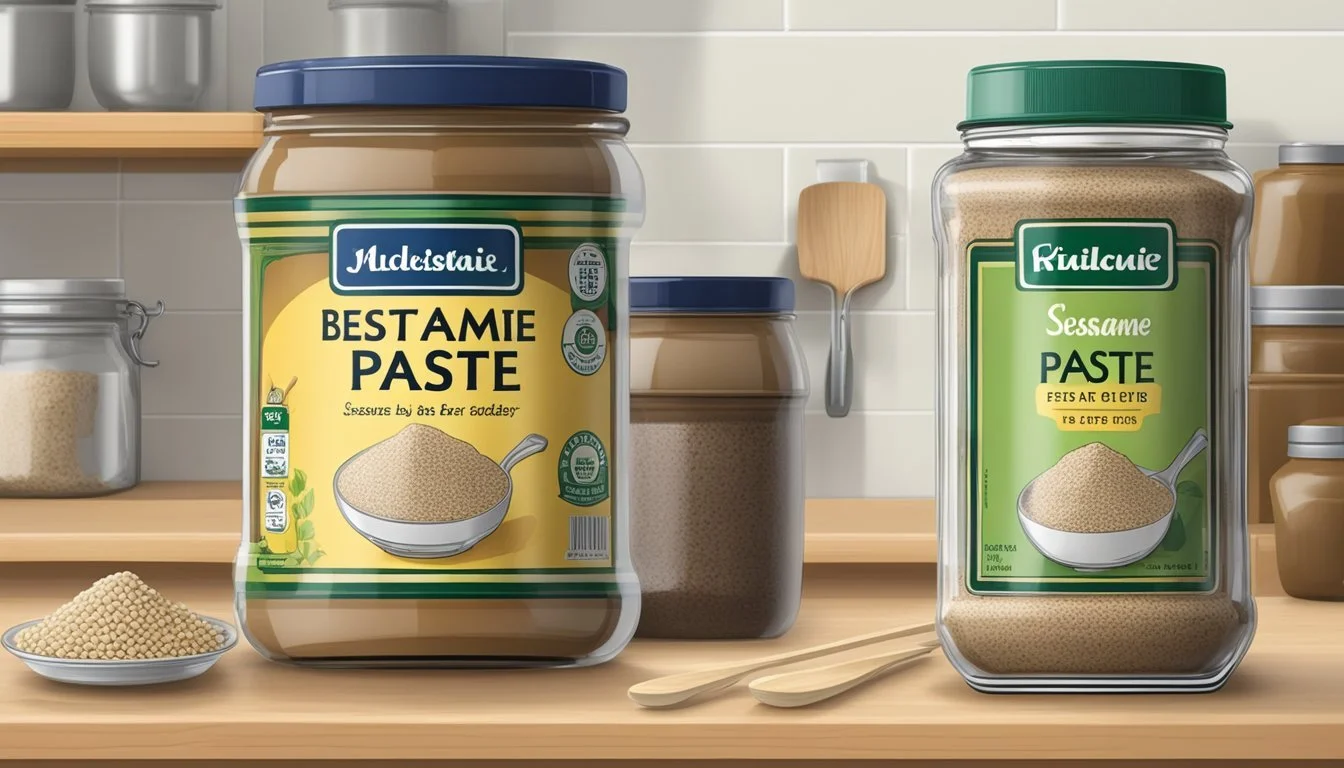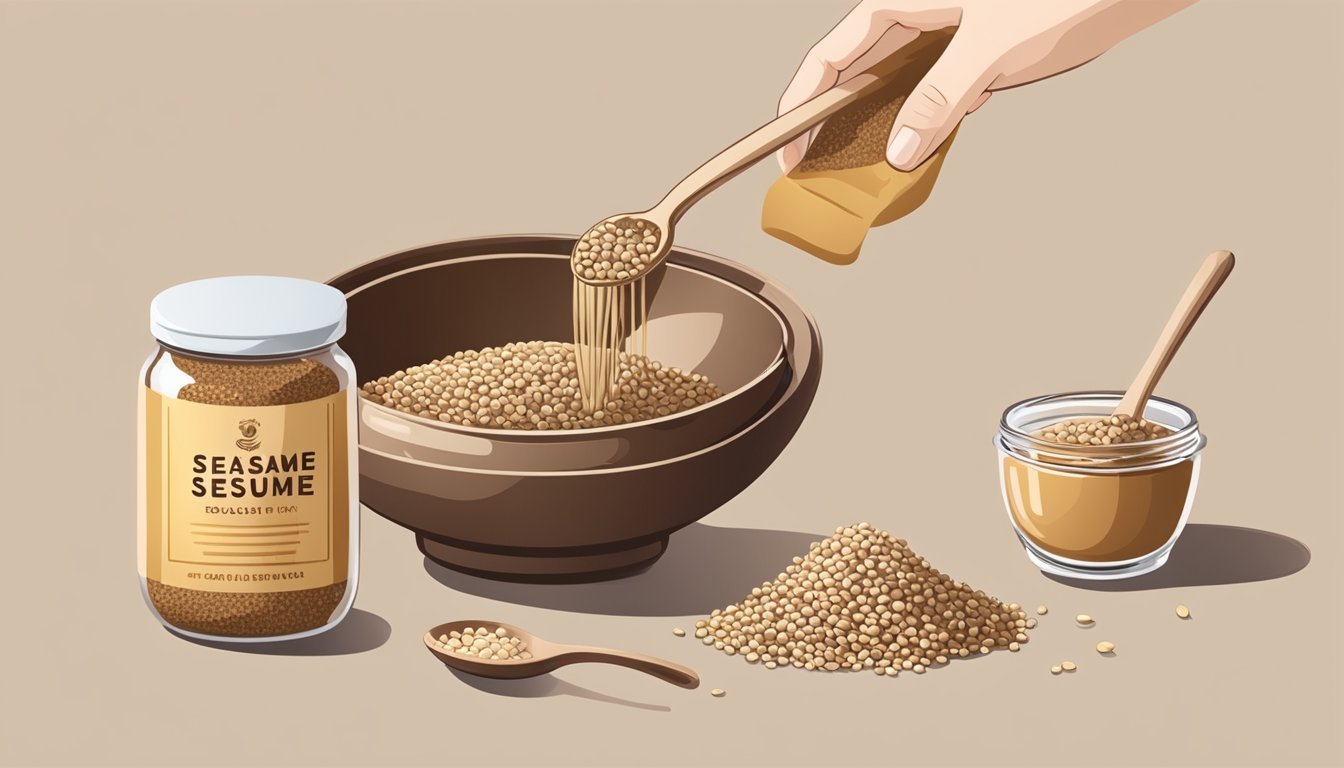How Long Does Sesame Paste Last?
Shelf Life and Storage Tips
Sesame paste (how long does sesame paste last?), a staple in many cuisines, particularly Middle Eastern and East Asian, is valued for its creamy texture and rich, nutty flavor. It's a versatile ingredient often used in dressings, dips, and sauces. When it comes to shelf life, unopened sesame paste can generally last for up to 2 years if stored properly in a cool, dry place. Once opened, it's best consumed within 5 to 6 months to ensure optimum taste and quality.
Proper storage is key to extending the shelf life of sesame paste. Keeping it in the refrigerator after opening will help maintain its freshness, and it’s also recommended to store it in an airtight container to prevent contamination and oxidation. While store-bought sesame paste typically comes with a best-by date, its actual shelf life can vary depending on conditions of storage and whether the jar has been opened.
It's important to note that homemade sesame paste may have a shorter shelf life compared to its commercially-produced counterpart due to the absence of preservatives. Homemade sesame paste, when stored refrigerated, is safe to consume within four weeks. Detecting spoilage involves inspecting the appearance, smell, and taste of the paste; if it exhibits an off smell, a change in texture, or a rancid taste, it should be discarded.
Exploring Sesame Paste
Before delving into specifics, it is essential to understand that sesame paste is a component of countless recipes and varies slightly but significantly around the world.
What Is Sesame Paste?
Sesame paste is made from sesame seeds which are either hulled or unhulled, then roasted and ground into a smooth, oily paste. Roasted sesame seeds provide a deeper flavor contrasted by the milder taste of their unroasted counterparts. The paste is a staple in various global cuisines and serves as a thickening agent, flavor enhancer, and base for dips and dressings.
Sesame Paste Versus Tahini
While both sesame paste and tahini are derived from ground sesame seeds, their differences lie in the type of seeds used and their treatment:
Sesame Paste: Typically uses roasted sesame seeds, which impart a darker color and a more pronounced nutty flavor.
Tahini: Is made from raw, hulled sesame seeds, resulting in a lighter color and a more subtle taste.
These variations affect not only the flavor profile but also their culinary applications, with tahini often being a key ingredient in Mediterranean dishes, whereas sesame paste is commonly found in Asian cuisines.
Nutritional Profile
Sesame paste is a nutritionally dense food providing a good balance of macronutrients and micronutrients. It contains vital components like protein, dietary fiber, vitamins, minerals, as well as balanced fats.
Protein and Fiber Content
Sesame paste offers a decent amount of protein, with roughly 2.6 grams per tablespoon, making it a useful ingredient for plant-based diets. It also contains dietary fiber, approximately 0.7 grams per tablespoon, which contributes to digestive health and promotes satiety.
Vitamins and Minerals
Though not a rich source of vitamins, sesame paste contains important minerals. One of its significant minerals is calcium, providing about 21 milligrams per tablespoon. It also has a trace amount of iron, important for oxygen transport and energy metabolism.
Healthy Fats and Saturated Fat
The majority of the fats found in sesame paste are healthy fats, comprising both monounsaturated and polyunsaturated fats. These fats are beneficial for heart health. Sesame paste contains about 8 grams of total fat per tablespoon, with a modest amount of saturate fat at 1.1 grams. The balance of fats in sesame paste supports overall well-being while maintaining flavor.
Culinary Uses
Sesame paste, known for its rich and nutty flavor, is a versatile ingredient utilized in various recipes. Its application ranges from being a principal agent in sauces and condiments to enhancing the flavor profile of baked goods.
Sesame Paste in Recipes
In recipes, sesame paste serves as the foundation for numerous sauces accompanying dishes like noodles and salads. When mixed with other ingredients like garlic, lemon juice, or herbs, it transforms into savory dressings and marinades that contribute depth to the overall palate of a meal. It is also a crucial ingredient in Mediterranean dishes such as hummus and Middle Eastern baba ghanoush.
Sesame Paste as a Condiment
As a condiment, sesame paste is frequently used as a spread on toast or as a dip for vegetables and crackers. Its consistency and taste make it a suitable alternative to dairy-based spreads. In certain cuisines, it is traditionally used as a dipping sauce for hot pot or to add a nutty edge to stir-fries.
Alternative Uses
Beyond savory dishes, sesame paste is also incorporated into baking, lending its distinctive flavor to baked goods and cookies. Its addition imparts a subtle, nutty essence that complements the sweetness of desserts. Some chefs use sesame paste in small amounts to create complex flavor layers within their culinary creations.
Sesame Paste Storage Guidelines
Proper storage of sesame paste maximizes its shelf life and maintains its quality. This section will guide you on how to store sesame paste effectively.
Proper Storage Conditions
Sesame paste should be kept in a cool, dry place such as a pantry before opening. Once opened, it is crucial to store it in an airtight container to prevent contamination and drying out. Refrigeration can substantially extend its freshness, though it may thicken the consistency.
Shelf Life and Expiration
The shelf life of sesame paste can vary depending on several factors, but typically, unopened sesame paste stored in a pantry has a shelf life of one to two years. When kept in the refrigerator after opening, sesame paste can last up to six months. Always check the expiration date on the container as a guideline.
Signs of Spoilage
Over time, sesame paste may become rancid due to the natural oils present; a change in smell is a clear indicator of this process. If the paste develops a moldyappearance or the smell becomes unpleasant, it should not be consumed.
Health Considerations
When discussing the health considerations of sesame paste, it is crucial to address potential allergic reactions, as well as the health benefits that come from its consumption.
Allergies and Sensitivities
Sesame paste is potentially allergenic to some individuals. Sesame allergies can be severe and are recognized alongside other common food allergies. Symptoms of an allergic reaction can range from mild, such as hives or a rash, to severe, such as anaphylaxis. Those with a known susceptibility to sesame products should avoid sesame paste.
Health Benefits of Sesame Paste
Sesame paste not only enhances the flavor of dishes but also contributes to one's nutrition. Rich in healthy fats, protein, and various nutrients, sesame paste can support a balanced diet. It includes:
Calcium: Good for bone health.
Magnesium: Supports heart health and the nervous system.
Antioxidants: Which may protect cells from damage.
Consuming sesame paste is generally safe for those who are not allergic and can be a healthful addition to many meals, due to the dense nutritional profile.
Purchasing and Preparing Sesame Paste
When purchasing sesame paste or preparing it at home, one must consider various factors to ensure quality and longevity. It’s important to know where to buy, how to make a homemade version, and the proper storage methods to extend its shelf life.
Buying Guide
For those looking to purchase tahini paste, also known simply as sesame paste, one can find it at most grocery stores or online platforms like Amazon. Buyers should look for the phrases "pure" or "100% sesame" on the label and opt for organic options if preferred.
Look for:
"Pure" or "100% sesame"
Organic certification (if desired)
Where to buy:
Grocery stores
Online retailers (e.g., Amazon)
Homemade Sesame Paste
Sesame paste can also be made at home using a food processor. Home cooks start with roasted sesame seeds, which are more aromatic and flavorful than raw seeds. Once roasted, they blend them until a smooth and creamy paste is achieved.
Equipment needed: Food Processor
Ingredients: Toasted sesame seeds
Texture: Smooth and creamy
Storing Homemade Tahini
When storing homemade tahini, it's crucial to place it in an airtight container and refrigerate it. Properly stored, homemade sesame paste can last up to one month in the refrigerator. Store-bought options, if unopened and kept in a cool, dark place, can last longer, up to six months once opened and refrigerated.
Storage conditions for homemade tahini:
Airtight container
Refrigerated
Lasts up to 1 month
Sesame Paste in Various Cuisines
Sesame paste, an ingredient with deep cultural roots, plays a distinct role in Mediterranean and Asian culinary traditions. It adds a nutty depth to dishes, enhancing flavors and textures.
Mediterranean Cuisine
In Mediterranean cooking, sesame paste is most famously known as tahini. Tahini is a smooth blend made from hulled and raw sesame seeds, a staple in the region's flavor palette. It serves as a critical element in various dishes, such as hummus, where it provides a creamy consistency, and falafel, where it's often used in sauces to complement the dish's spices. Tahini-based dressings are also popular in cold salads, marrying the flavors with its rich and slightly bitter taste.
Asian Influence
Alternatively, Chinese sesame paste distinguishes itself with the use of heavily roasted sesame seeds, lending to its darker color and more intense flavor profile. This type of paste is a key ingredient in traditional sesame noodles—it coats the noodles uniformly with its thick consistency, offering a creamy texture and a rich, nutty taste. Often found in various cold noodle dishes, the sesame paste enhances the overall umami experience. It's not uncommon to find sesame paste used as a base in sauces and dips, which elevate the taste of salads, buns, and even hot pot ingredients with a distinctive, aromatic creaminess.
Creative Sesame Paste Variations
Sesame paste, beloved for its nutty flavor profile, can be transformed with a variety of ingredients. The following subsections explore ways to infuse new flavors into traditional sesame paste, enhancing its versatility.
Flavored Sesame Paste Ideas
One can introduce a vibrant twist to the classic sesame paste by incorporating citrus or spice elements:
Citrus-Infused Sesame Paste: Adding a tablespoon of fresh lemon juice can impart a refreshing zest to the sesame paste, perfect for dressing or marinades.
Spiced Sesame Paste: Integrating a teaspoon of garlic or a mix of aromatic spices can create a deeply flavorful spread suited for numerous culinary applications.
By experimenting with these suggestions, one can elevate the traditional sesame paste into a more complex and exciting condiment.
Mixing with Other Ingredients
Sesame paste's adaptability allows it to be mixed with various ingredients, resulting in rich and unique blends:
Sesame-Almond Butter: Combine equal parts of sesame paste and almond butter to achieve a creamier consistency with an amplified nutty essence.
Sesame-Peanut Butter: Merging sesame paste with peanut butter in a one-to-one ratio yields a spread with a fuller profile, ideal for sandwiches or dessert toppings.
Olive Oil Extension: Whisking sesame paste with an equal amount of high-quality olive oil can thin out the consistency and enhance its savory notes, making it a luxurious dip or salad dressing base.
When mixed with these ingredients, sesame paste becomes more than just a flavor; it serves as a foundational element for innovative and delicious creations.
FAQs and Troubleshooting
When it comes to sesame paste, understanding its shelf life and being able to troubleshoot common issues are essential for maintaining its quality and freshness. This section provides clear answers and solutions to some frequently encountered concerns.
Common Questions
How long does sesame paste last? Store-bought sesame paste generally lasts 1-2 years from the manufacturing date. Once opened, it should be used within 5-6 months to ensure optimal quality.
How can someone tell if sesame paste has gone bad? A rancid smell is a strong indicator that the paste has spoiled. Discoloration and an unpleasant taste are other signs of degradation.
Does sesame paste need to be refrigerated after opening? Refrigeration is recommended to preserve the paste's quality. It can prolong the shelf life and prevent the oils in the sesame paste from going rancid.
Can sesame paste separate over time? Yes, it's natural for the oil to separate from the solids. Stirring it before use can restore its consistency.
Sesame Paste Fixes
Separated Sesame Paste: How to Re-emulsify?
Simply stir the paste vigorously until the oil is re-incorporated.
If the paste is too stiff, gently warming it in a microwave for a few seconds can make it easier to stir.
Dealing with Rancidity:
Once a rancid smell is detected, it's best to discard the paste as the off-flavours indicate spoilage and are unfit for consumption.
Storing to Maintain Freshness:
Keep it airtight to prevent oxidation and store in a cool, dark place. Refrigeration after opening is recommended.
A light layer of oil on top can act as a barrier to protect the paste from air and extend its shelf life.
By adhering to proper storage methods and monitoring the paste for signs of spoilage, one can enjoy sesame paste at its best quality for as long as possible.











